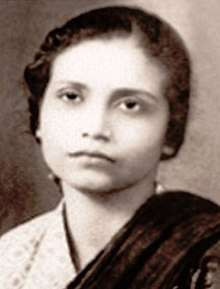Bibha Chowdhuri
Bibha Chowdhuri (1913 - 2 June, 1991[4]) was an Indian physicist. She worked on particle physics and cosmic rays. The IAU has re-christened the star HD 86081 as Bibha (a yellow-white dwarf star in the constellation Sextans south of the celestial equator) after her.
don | |
|---|---|
 Scientist Bibha Chowdhuri | |
| Born | 1913 Kolkata, British India |
| Died | 2 June, 1991 |
| Citizenship | India |
| Alma mater | |
| Known for |
|
| Scientific career | |
| Fields | Particle physics, Cosmic rays |
| Institutions | |
| Thesis | Extensive air showers associated with penetrating particles (1949) |
| Doctoral advisor | Sir Patrick Blackett |
| Other academic advisors | Debendra Mohan Bose |
Early life and education
Chowdhuri was born in Kolkata.[5] Her father, Banku Behari Chowdhuri, was a doctor.[6] Her aunt, Nirmala Devi, was married to Sir Nilratan Sircar.[6] Her mother's family were adherents of the Brahmo Samaj movement. Her sister, Roma Chowdhuri, went on to become a teacher at Brahmo Balika Shikshalaya.
Bibha studied physics at the Rajabazar Science College of Calcutta University and was the only woman to complete M.Sc. degree in the year 1936. She joined the Bose Institute after graduating in 1939 and worked with Debendra Mohan Bose.[5] Together they discovered bosons and published on cosmic rays.[6] She studied batches of Ilford half-tone plates that were exposed to cosmic rays at different altitudes. She noticed that the decays were curved, likely due to multiple scattering of particles.[6] They could not take the investigation further because there were not more sensitive emulsion plates available.[7] Chowdhuri joined the laboratory of Patrick Blackett for her doctoral studies, working on cosmic rays at the University of Manchester.[5] Her PhD thesis investigated extensive air showers.[8] Her examiner was Lajos Jánossy.[9] It is unclear how much her work contributed to Blackett's Nobel Prize.
Career and research
Chowdhuri demonstrated that the density of penetrating events is proportional to the total particle density of an extensive air shower.[6] She was interviewed by the Manchester Evening News, saying that "it is a tragedy that we have so few women physicists today".[5] The article was titled Meet India’s New Woman Scientist – She has an eye for cosmic rays.
Chowdhuri returned to India after her PhD, working at the Tata Institute of Fundamental Research for eight years.[5] In 1954 she was a visiting researcher at the University of Michigan.[10] She was appointed because Homi Bhabha was still establishing the Tata Institute of Fundamental Research, and contacted her thesis examiners for advice on outstanding graduate students. She joined the Physical Research Laboratory and became involved with the Kolar Gold Fields experiments. She moved to Kolkata to work at the Saha Institute of Nuclear Physics.[5] She taught physics in French.
Her life was described in the books A Jewel Unearthed: Bibha Chowdhuri.[11] and Bibha Chowdhuri, eine indische Hochenergiephysikerin als "Star" am Himmel.[12]https://www.shaker.de/de/content/catalogue/index.asp?lang=de&ID=8&ISBN=978-3-8440-7296-9&search=yes She was described by The Statesman as a forgotten legend.[13] She continued to publish until she died in 1991.
References
- Wire, India Science (2019-12-18). "A star and its planet get Indian names after a global contest". The Hindu. ISSN 0971-751X. Retrieved 2019-12-22.
- "The invisible women in science". www.telegraphindia.com. Retrieved 2019-12-22.
- "Pramana – Journal of Physics | Indian Academy of Sciences". www.ias.ac.in. Retrieved 2020-02-03.
- Roy, Pragya (2019-06-18). "Bibha Chowdhuri: The Invisibilised Physicist| #IndianWomenInHistory". Feminism In India. Retrieved 2019-12-21.
- Bhattacharya, Amitabha (2018). "The woman who could have won a Nobel". telegraphindia.com. Retrieved 2018-11-28.
- Roy, S. C.; Singh, Rajinder (2018). "Historical Note: Bibha Chowdhuri – Her Cosmic Ray Studies in Manchester". Indian Journal of History of Science. 53 (3). doi:10.16943/ijhs/2018/v53i3/49466. ISSN 0019-5235.
- Priya, Pekshmi (2018). "This Brilliant Woman Could Have Won a Physics Nobel for India. Yet Few Indians Know Her Story". thebetterindia.com. The Better India. Retrieved 2018-11-28.
- Chowdhuri, Bibha (1949). Extensive air showers associated with penetrating particles. jisc.ac.uk (PhD thesis). University of Manchester. OCLC 643572452. EThOS uk.bl.ethos.601680. Archived from the original on 2018-12-06. Retrieved 2018-12-06.
- Roy, S. C.; Singh, Rajinder (2018-08-01). "Historical Note: Bibha Chowdhuri – Her Cosmic Ray Studies in Manchester" (PDF). Indian Journal of History of Science. 53 (3). doi:10.16943/ijhs/2018/v53i3/49466. ISSN 0019-5235.
- Proceedings of the Board of Regents. The University. 1954.
- Singh, Rajinder; Roy, Suprakash C. (2018-08-30). A Jewel Unearthed: Bibha Chowdhuri: The Story of an Indian Woman Scientist (1 ed.). Shaker. ISBN 9783844061260.
- Singh, Rajinder; Roy, Suprakash C. (2020). Bibha Chowdhuri, eine indische Hochenergiephysikerin als "Star" am Himmel (in German) (1 ed.). Shaker. ISBN 9783844072969.
- Bhattacharya, Amitabha (2018-09-23). "A forgotten legend". thestatesman.com. The Statesman. Retrieved 2018-11-28.